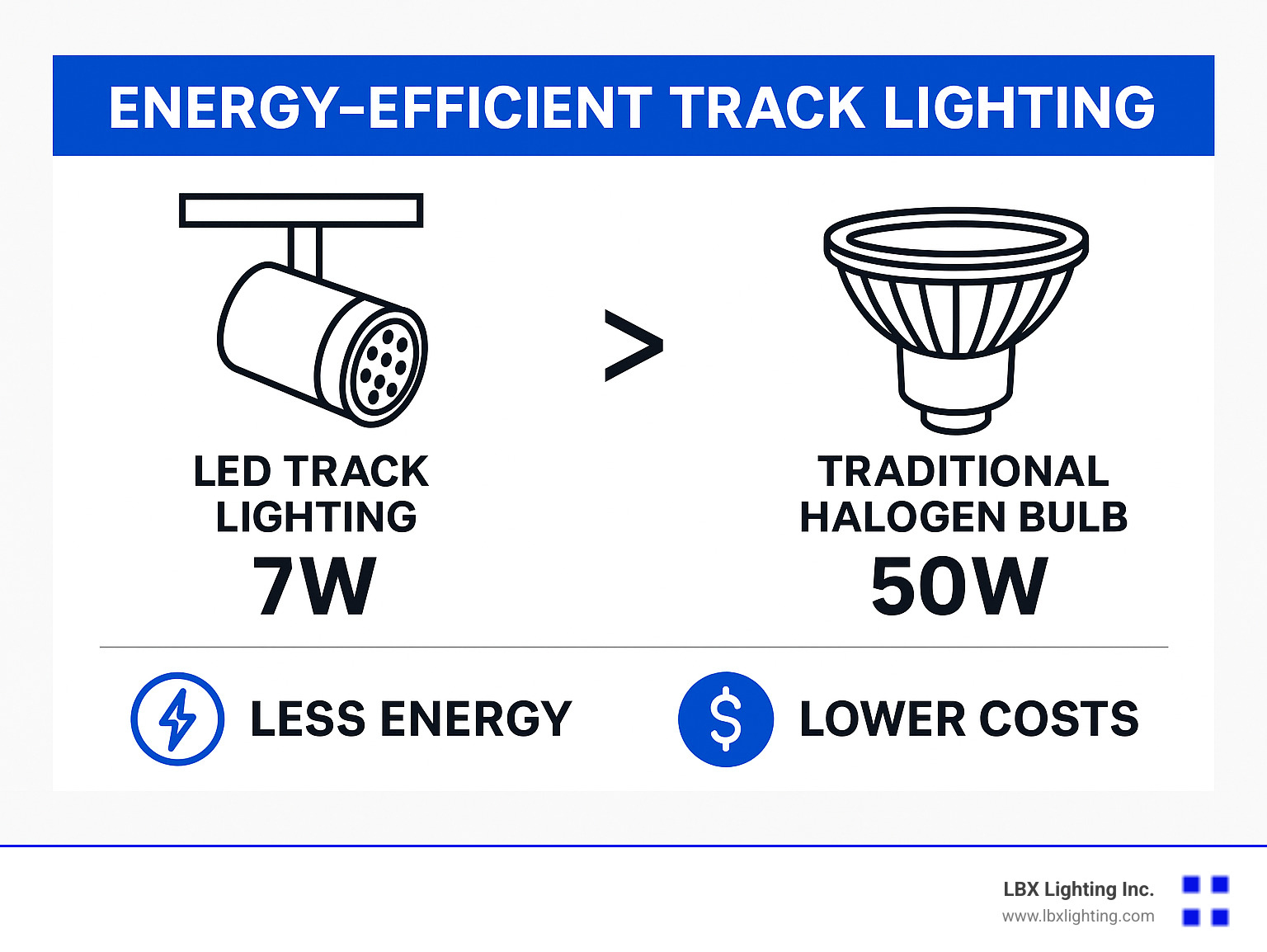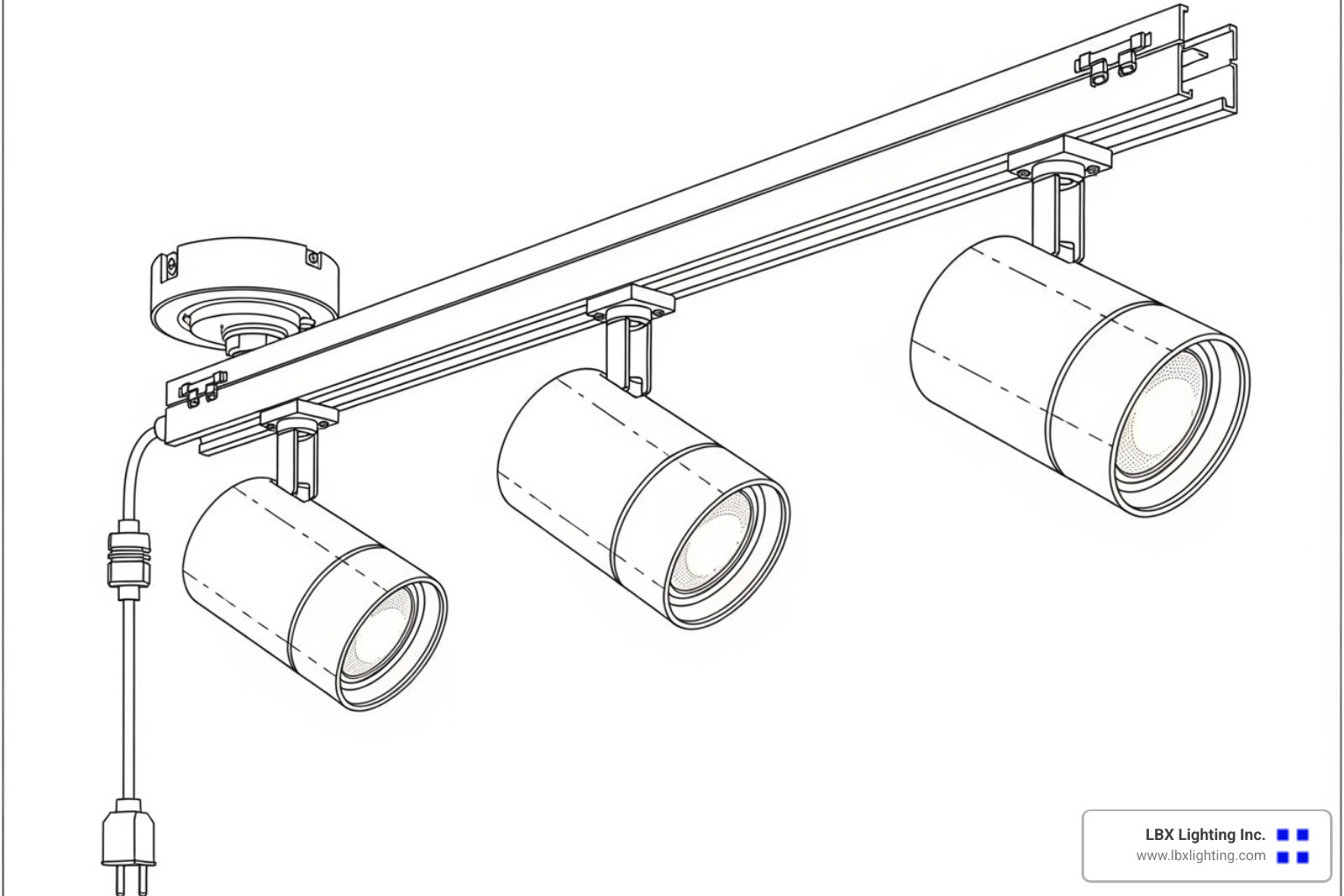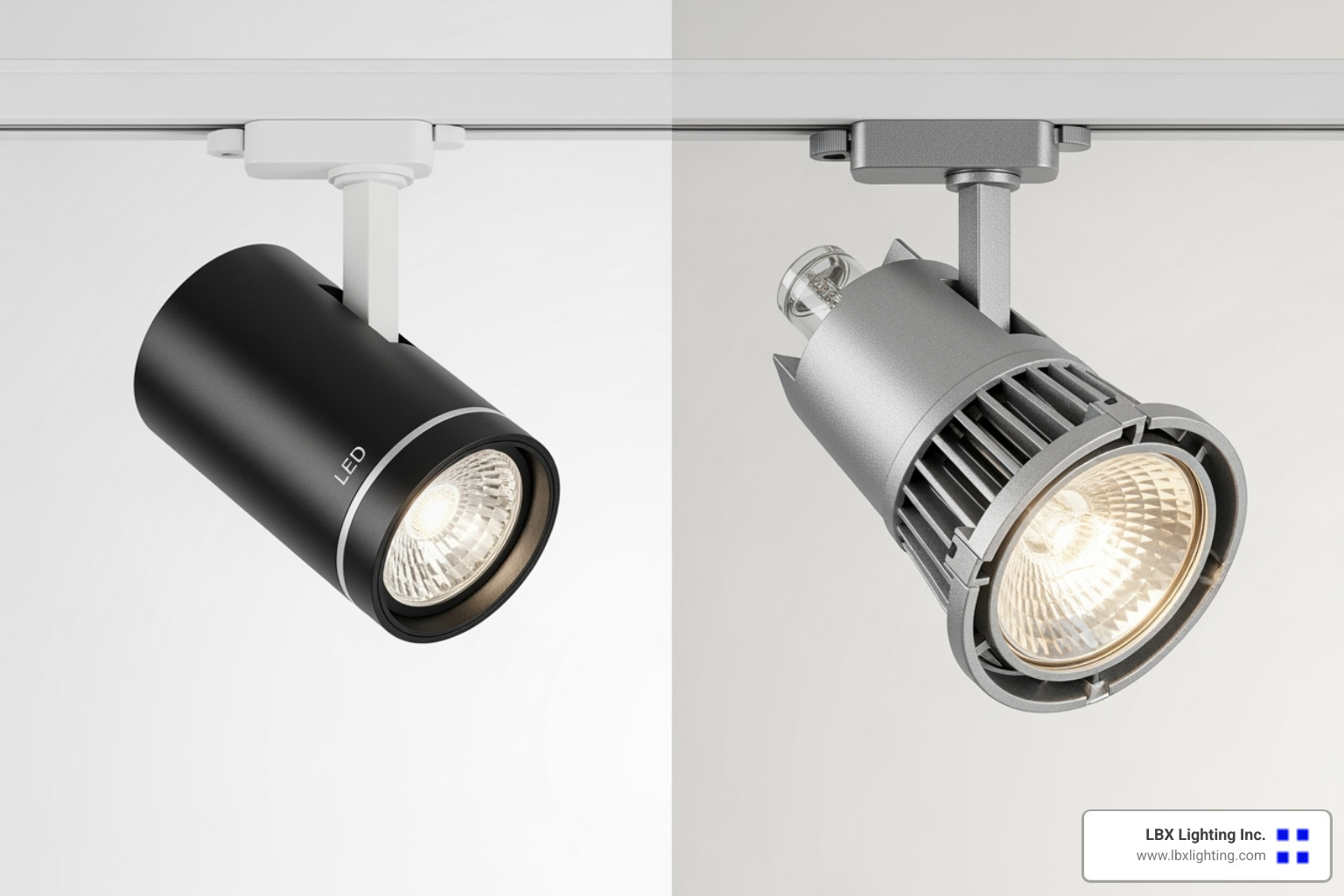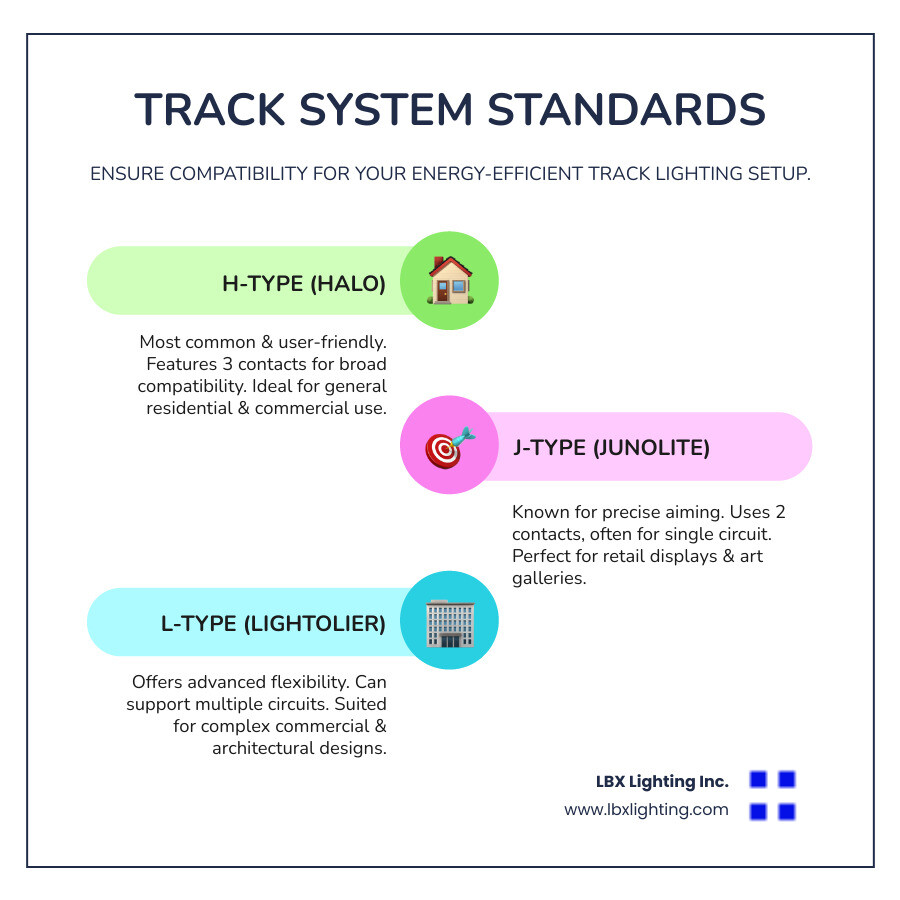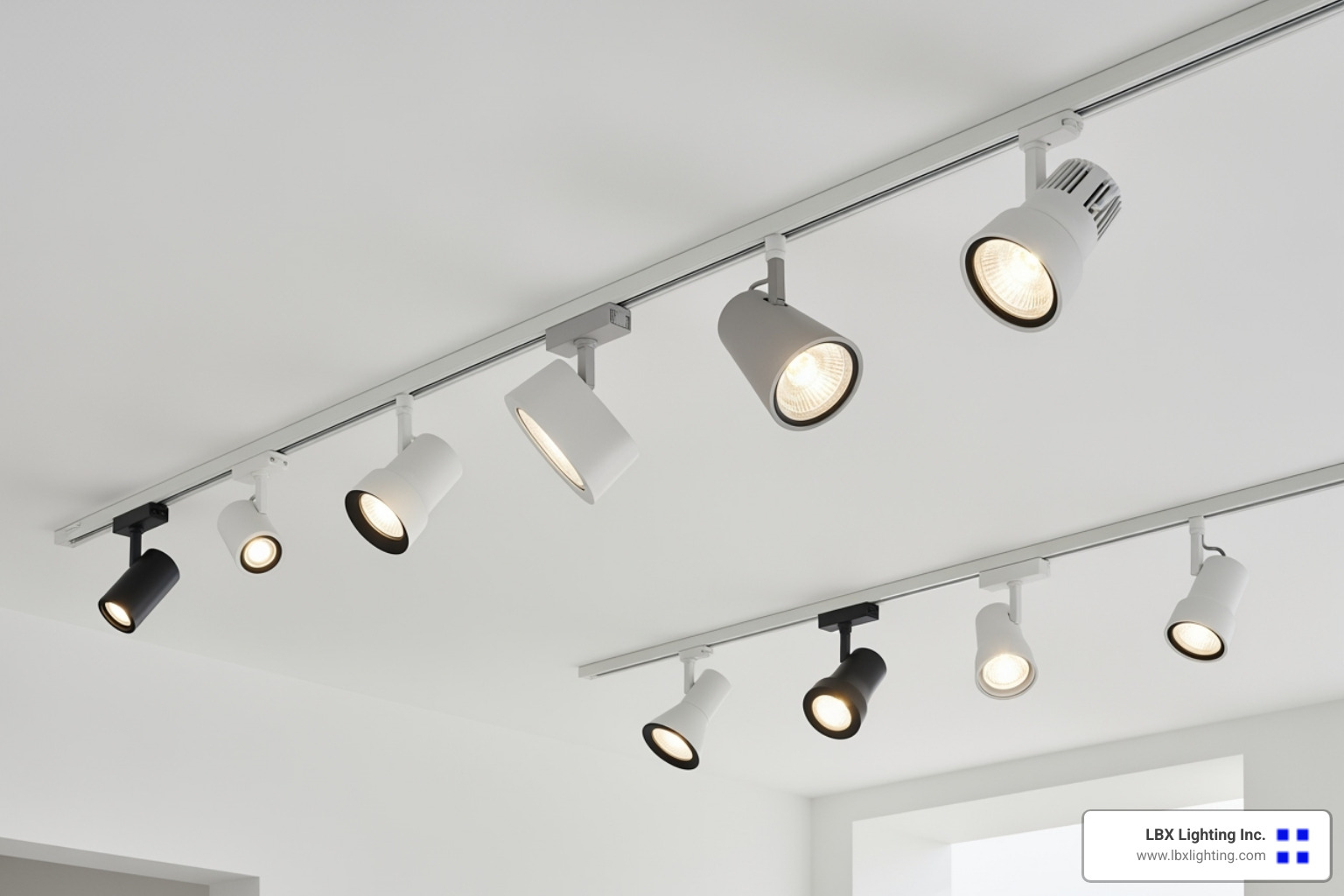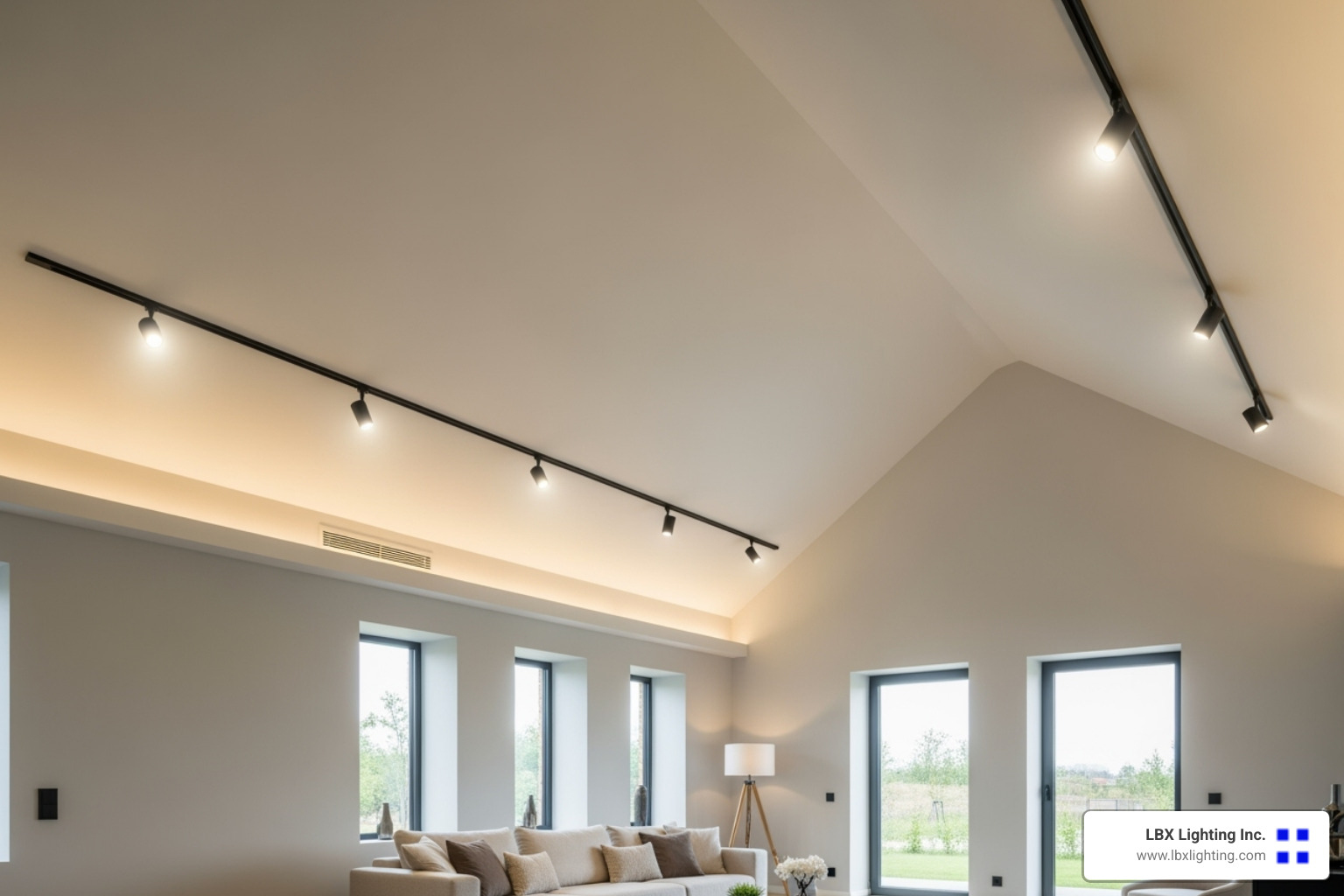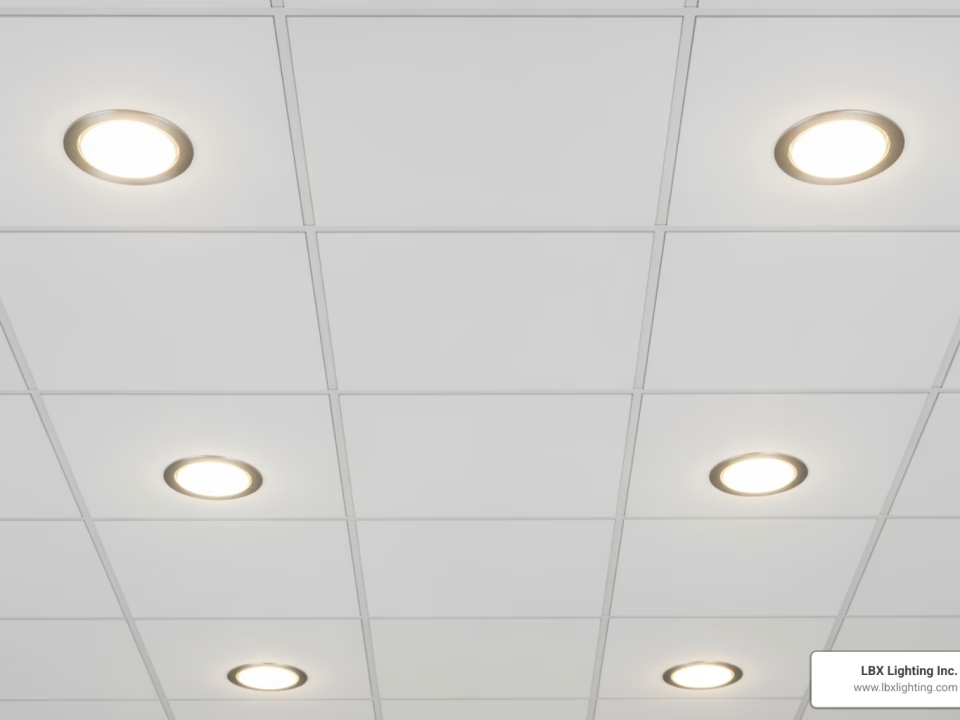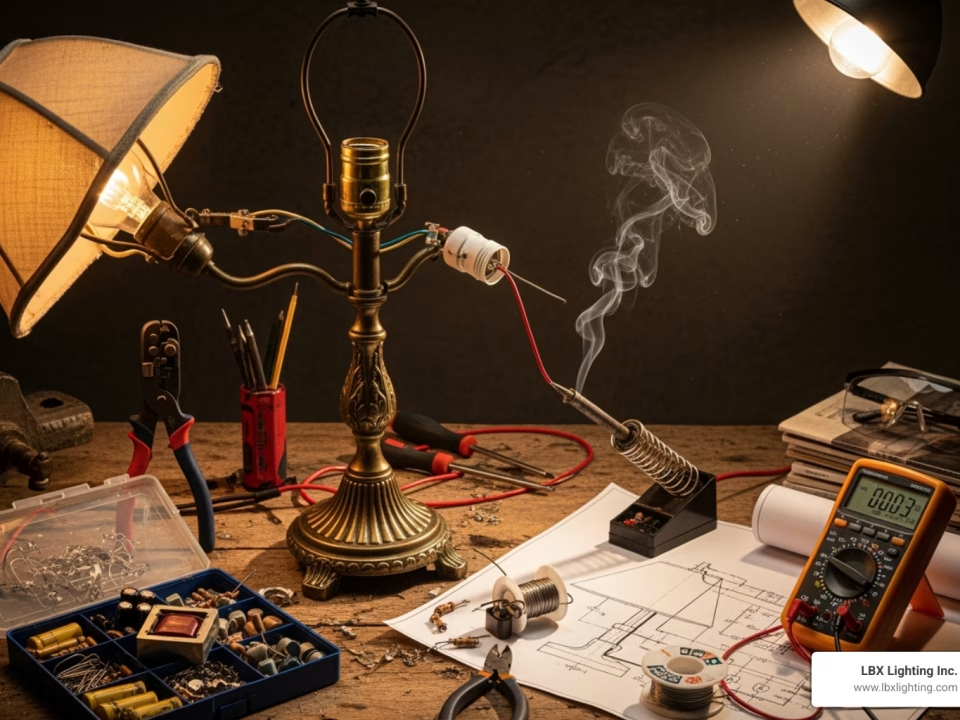
Shine Bright Like a Diamond—Crystal Chandeliers for Your Dining Room
July 15, 2025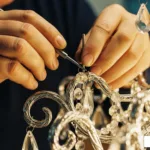
Crystal Clear Choices: Best Chandelier Repair in Houston TX
July 16, 2025Illuminate Your Space with Energy-Efficient Track Lighting
Investing in energy efficient track lighting can transform any space, offering both dynamic illumination and significant cost savings. If you’re looking for a quick answer on why it’s a smart choice, here’s the key benefit:
- LED track lighting uses far less energy than old bulbs. For example, a 7-watt LED track head can give you the same light as a 50-watt traditional bulb. That’s huge energy savings!
Track lighting has long been a favorite for its ability to direct light precisely where it’s needed. Modern advancements, especially in LED technology, have made these systems even more appealing. They offer incredible versatility, sleek aesthetics, and powerful control over your lighting environment. You can highlight a favorite painting, brighten a workspace, or set the perfect mood, all while using less power.
As a lighting expert at LBX Lighting, I’ve seen the evolution of illumination. My commitment is to help you find reliable, top-quality energy efficient track lighting solutions that exceed expectations. This guide will walk you through everything you need to know about these innovative systems.
What is Track Lighting? A Breakdown of the Basics
Imagine a world where your lights aren’t stuck in one place, staring blankly ahead. That’s the magic of track lighting! It’s a highly versatile lighting system featuring a continuous track channel, typically mounted to ceilings, but sometimes to walls. Attached to this track are individual light fixtures, often called “track heads,” that can be moved, aimed, and even removed or added as your needs change.
This dynamic setup allows for incredibly precise, directional lighting. Whether you’re highlighting a prized art piece, illuminating a product display in a retail store, or simply directing light onto your kitchen island for a Thanksgiving spread, track lighting gives you the control. All the fixtures on a single track system operate from one central power source, simplifying installation while maximizing flexibility.
Track lighting proves its worth in diverse environments, from residential living rooms to commercial spaces, retail stores, and art galleries. It’s a chameleon of the lighting world, offering solutions for virtually any application. Need to learn more about selecting the right system for your space? Check out our In-Depth Guide To Finding The Best Track Lighting.
Core Components of a Track Lighting System
Understanding the building blocks of a track lighting system helps us appreciate its adaptability. Here’s what you’ll typically find:
- Track Rail: This is the backbone of the system – a linear metal channel that houses the electrical conductors. It comes in various lengths and can be cut to size or joined together.
- Power Feed: This is how the track connects to your home or business’s electrical supply. Power feeds can be located at the end of a track run (end feed), in the middle (middle feed), or even as a “floating feed” that can be positioned anywhere along the track.
- Connectors: When you need to extend your track or create different shapes, connectors come into play. These can be straight couplers, L-shaped, T-shaped, or even X-shaped to form intricate lighting layouts.
- Track Heads: These are the individual light fixtures that snap into the track. They are designed to slide along the track and rotate, allowing you to direct light precisely where it’s needed.
- Light Fixtures (Bulbs/Integrated LEDs): Within the track heads are the actual light sources. While older systems used traditional bulbs, modern energy efficient track lighting primarily uses integrated LEDs or accepts LED bulbs. For more on light sources, explore our options for Light Bulbs.
Track Lighting vs. Fixed Rail Lighting
Track lighting and fixed rail lighting are distinct in their function and flexibility.
The key differences lie in their mounting, adjustability, and overall flexibility:
- Mounting: Track lighting is most commonly ceiling-mounted, though it can also be wall-mounted. Fixed rail lighting, on the other hand, is almost exclusively wall-mounted. You’ll often spot fixed rail lighting in bathrooms, positioned above vanity mirrors, providing a static, dedicated light source.
- Adjustability: This is where track lighting truly shines. Track heads can be moved along the entire length of the track, rotated, and tilted to illuminate different areas or objects. Fixed rail lighting offers very little, if any, adjustability. Once installed, its light direction is largely set.
- Flexibility: Track lighting allows you to add more lights, remove existing ones, or completely reconfigure their positions as your needs change. Fixed rail lighting is a more permanent fixture; you can’t easily add or subtract lights, and their placement is fixed.
For dynamic, adaptable lighting that can evolve with your space, track lighting is your go-to. If a static, dedicated light source is all you require, fixed rail lighting might suffice, but it lacks the freedom of track.
The Power of LED: Unpacking the Benefits of Energy Efficient Track Lighting
LEDs are the engine behind modern energy efficient track lighting. By turning most of the electricity they use into visible light (instead of heat), they deliver far more brightness per watt than legacy bulbs. A compact 7-watt LED track head easily rivals the output of a 50-watt halogen bulb—that’s the kind of leap that shrinks electric bills without dimming your space.
Curious about how LEDs achieve this? The U.S. Department of Energy explains the science in plain language.
Why LEDs Rule the Track
- Lower Wattage, Higher Lumens – More light, less power. Simple math that saves money every month.
- Minimal Heat – Cool operation means safer fixtures, happier A/C systems, and no scorched fingertips.
- 50,000-Hour Lifespan – Run a fixture 8 hours a day and it can last 17+ years before replacement.
- Excellent Color Rendering (CRI 80-90+) – Colors stay true, whether you’re lighting artwork or tonight’s dinner.
For quick tips on slashing energy use throughout the house, see our Simple Money Saving Lighting Tips For Homeowners.
Lower Bills, Smaller Footprint
Because LEDs sip power, the effect on your utility statement is immediate—especially if you’re replacing multiple incandescent or halogen fixtures. Fewer bulb changes mean even more savings in both dollars and ladder climbs.
Environmentally, the gains are just as impressive. Reduced electricity demand lowers carbon emissions, and the long life of LEDs keeps tons of glass and metal out of landfills. Unlike some fluorescent options, LEDs are mercury-free from start to finish. Learn more in our guide to Eco-Friendly Lighting Solutions.
Built to Perform, Built to Last
LED track heads are designed for longevity. Their solid-state construction resists vibration, and their cool operation protects delicate décor. Once you aim an LED track head, it will perform reliably for years with virtually no maintenance.
Need more reasons to accept LED? Check out our in-store demos at LBX Lighting to see how bright, efficient, and stylish today’s track systems can be.
Choosing Your System: A Guide to Track Types and Configurations
Ready to dive into the exciting world of energy efficient track lighting? Great! But before you choose your track heads, let’s talk about the “track” itself. Choosing the right track system is crucial to ensure everything works together, fits your project needs, and helps you create the look you’re dreaming of. At LBX Lighting, we have a comprehensive range of Track Lighting solutions ready for you.
Understanding Track System Standards (H, J, & L)
When choosing track lighting, you’ll encounter different system standards, commonly known as H-Type, J-Type, and L-Type. These letters refer to the specific design of the track and the connectors on the light fixtures. Just like you can’t mix and match different types of phone chargers, these track systems are not interchangeable. It’s crucial to ensure your track and fixtures are compatible to avoid installation issues.
This table gives you a quick look at the main differences:
| Track Type | Contact Points | Common Characteristics | Ideal Applications |
|---|---|---|---|
| H-Type | 3 (two power, one ground) | Easiest to install, widely available, single circuit, versatile for general use | Residential, small commercial, general lighting |
| J-Type | 2 (one power, one ground) | Known for precise aiming, often used in retail for accent lighting, single circuit | Retail, art galleries, accent lighting, task lighting |
| L-Type | 2 (two power, one ground, but different configuration from H) | Designed for greater flexibility, often multi-circuit, allowing independent control of groups of lights | Commercial, architectural, complex lighting designs |
Let’s break them down a little more:
-
H-Type Track Lighting: This is the most common system, recognizable by its three electrical contacts. It’s known for simple installation and compatibility with a wide variety of fixtures. For straightforward, reliable track lighting in homes or small businesses, H-Type is an excellent choice. We offer dedicated H-Style Track Lighting options to get you started.
-
J-Type Track Lighting: This system uses a different contact configuration and is often chosen for applications requiring precise aiming. This makes it a favorite for retail stores or art galleries where highlighting specific items is key.
-
L-Type Track Lighting: While less common in homes, L-Type is excellent for larger commercial projects. It offers greater flexibility by supporting multiple circuits on a single track. This allows for independent control over different groups of lights, enabling complex lighting designs.
Compatibility is key! A fixture will only work on its corresponding track type. Always double-check the system you have or are buying to ensure a smooth setup.
Selecting the Right Track Form and Voltage
Beyond the system type (H, J, or L), you’ll also choose the track’s form and voltage. These options are designed for specific aesthetic and functional needs.
First, the shapes:
-
Rigid Tracks (or Linear Tracks) are classic straight lines, perfect for long hallways or kitchens where a clean, modern line is desired.
-
Flexible Tracks are ideal for creative spaces with curved walls or unique ceiling shapes. They bend to follow contours, offering design freedom that rigid tracks cannot.
-
Monorail Systems are a more decorative option. These systems use thin, bendable rails that can be sculpted into artistic shapes, supporting spotlights or small pendant lights to make a design statement.
Now, let’s talk about voltage:
-
Line Voltage Systems connect directly to standard 120V household electricity without needing a transformer. This simplicity makes them the most common choice, and most energy efficient track lighting systems, especially LEDs, are designed for line voltage.
-
Low Voltage Systems operate at 12V or 24V and require a transformer to reduce the household voltage. They are often used for smaller fixtures or when precise, soft lighting is desired. The energy savings still come from using efficient LED bulbs, which are standard for both system types.
Customizing Your Light: Features for Versatility and Efficiency
A compelling aspect of energy efficient track lighting is its customizability, blending aesthetics with functionality. You can create a solution that perfectly matches your space and lifestyle, whether you prefer a sleek, modern look or something more characterful, like Industrial Style Track Lighting. Mix and match different track head styles on the same track—spotlights for focused tasks, pendants for ambient warmth, and floods for general illumination—to get exactly what you need.
How Adjustability and Dimming Boost Efficiency
Adjustability is more than a design feature; it’s a powerful energy-saving tool. Directing light precisely where needed prevents wasting electricity on empty corners.
Unlike fixed lights that illuminate broadly, track heads can be aimed with precision. Highlighting a bookshelf or brightening a workspace means no wasted light or energy. Most quality track heads offer impressive 350-degree rotation and 90-degree tilt, giving you complete control. This allows you to adapt your lighting perfectly, even if you rearrange your furniture.
Dimmers take efficiency to the next level. Using less than full brightness dramatically cuts energy use, and dimmed LEDs last even longer. It’s a win-win that saves money while creating the perfect mood for any occasion.
For comprehensive control over your lighting environment, explore our Lighting Control Systems.
The Role of Color Temperature and Smart Controls in your energy efficient track lighting
Beyond brightness and direction, light quality transforms a space. Color temperature and smart controls are game-changers for your energy efficient track lighting.
Color Temperature (CCT), measured on the Kelvin scale, describes whether light feels warm and cozy or cool and crisp. Warm light (2700K-3000K) creates an inviting, sunset-like glow for living rooms, while cool light (4000K-5000K) mimics daylight to keep you alert in kitchens and offices. Many modern LED track lights offer selectable color temperatures, allowing you to set the perfect mood for any situation—warm for relaxing, cool for focus.
Smart controls take customization to a new level. Integrating your energy efficient track lighting with smart home systems open ups advanced features. You can schedule lights, create scenes for different activities, and control everything from your phone. Voice control adds convenience, but these are also powerful energy-saving tools, ensuring lights are only on when needed and at the optimal brightness.
Ready to dive deeper into smart illumination? Check out our Smart Home Lighting solutions to see how technology can make your lighting smarter and more efficient.
Installation Insights: Planning Your Track Lighting Project
Planning your energy efficient track lighting project is a crucial first step that saves time and prevents headaches later. While many systems are DIY-friendly, safety is paramount. If you’re uncomfortable with electrical work, consult a professional. For more guidance, our guide on How To Develop A Lighting Plan is a valuable resource!
Creating a Smart Lighting Plan
A smart lighting plan is your blueprint for both aesthetics and functionality. Here’s how to create one:
- Sketch your room layout. Decide if your track will be straight or a more complex L- or U-shape. Flexible tracks can even follow curves.
- Identify focal points. Plan your track to highlight art, collectibles, or architectural features.
- Plan for task lighting. Position track heads to provide focused, bright light over kitchen islands, desks, or craft tables.
- Incorporate accent lighting. Use light to wash a textured wall or create dramatic shadows, adding depth and interest.
- Consider ambient lighting. Blend your track lighting with other light sources to create a balanced, inviting atmosphere.
Technical Considerations for your energy efficient track lighting
Before installation, review these technical details for a smooth, safe setup of your energy efficient track lighting.
- Locate your power source. Your track connects to an electrical junction box. Ensure it’s in an ideal location and can support the weight of the track system. An electrician can move or add a junction box if needed.
- Consider ceiling height. High ceilings may require brighter track heads with narrower beams. Lower ceilings benefit from wider beam angles to avoid hot spots and create even illumination.
- Accommodate sloped ceilings. Many systems offer standoff adapters to mount tracks securely and level on angled or vaulted ceilings, ensuring lights hang straight.
- Explore wiring-free solutions. Some kits offer plug-in options that connect to a standard wall outlet, eliminating the need for hardwiring. These are convenient but offer less placement flexibility.
Above all, prioritize safety. If you’re ever unsure, consult a qualified electrician.
Conclusion: Illuminate Your Space the Smart Way
Energy efficient track lighting is a game-changer for modern spaces. It’s the Swiss Army knife of lighting: versatile, reliable, and powerful.
The benefits are clear:
- Versatility to adapt to any need, from accenting art to task lighting.
- Style that improves your décor with sleek, contemporary designs.
- Significant energy savings, with a 7-watt LED replacing a 50-watt traditional bulb.
- Durability that reduces maintenance and hassle.
- Unprecedented control through dimmers, color temperature selection, and smart home integration.
Investing in energy efficient track lighting is a smart choice for your future. You’re choosing flexibility, efficiency, and style—a modern solution that delivers on its promises.
At LBX Lighting Inc., we’ve been helping Houston residents and businesses find the perfect lighting solutions for their unique needs. Our expert staff understands that lighting isn’t just about brightness – it’s about creating spaces where life happens. With our competitive pricing and exceptional customer service, we’re here to guide you through every step of your lighting journey.
Ready to see what energy efficient track lighting can do for your space? For local expertise and personalized service, explore our LED Lighting Houston solutions. When you’re ready to take the next step, explore our complete range of track lighting solutions and let us help you illuminate your space the smart way.



